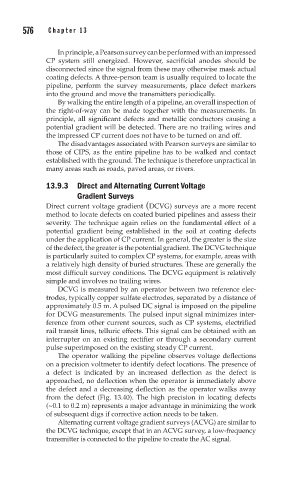Page 613 - Corrosion Engineering Principles and Practice
P. 613
576 C h a p t e r 1 3 C a t h o d i c P r o t e c t i o n 577
In principle, a Pearson survey can be performed with an impressed
CP system still energized. However, sacrificial anodes should be
disconnected since the signal from these may otherwise mask actual
coating defects. A three-person team is usually required to locate the
pipeline, perform the survey measurements, place defect markers
into the ground and move the transmitters periodically.
By walking the entire length of a pipeline, an overall inspection of
the right-of-way can be made together with the measurements. In
principle, all significant defects and metallic conductors causing a
potential gradient will be detected. There are no trailing wires and
the impressed CP current does not have to be turned on and off.
The disadvantages associated with Pearson surveys are similar to
those of CIPS, as the entire pipeline has to be walked and contact
established with the ground. The technique is therefore unpractical in
many areas such as roads, paved areas, or rivers.
13.9.3 Direct and Alternating Current Voltage
Gradient Surveys
Direct current voltage gradient (DCVG) surveys are a more recent
method to locate defects on coated buried pipelines and assess their
severity. The technique again relies on the fundamental effect of a
potential gradient being established in the soil at coating defects
under the application of CP current. In general, the greater is the size
of the defect, the greater is the potential gradient. The DCVG technique
is particularly suited to complex CP systems, for example, areas with
a relatively high density of buried structures. These are generally the
most difficult survey conditions. The DCVG equipment is relatively
simple and involves no trailing wires.
DCVG is measured by an operator between two reference elec-
trodes, typically copper sulfate electrodes, separated by a distance of
approximately 0.5 m. A pulsed DC signal is imposed on the pipeline
for DCVG measurements. The pulsed input signal minimizes inter-
ference from other current sources, such as CP systems, electrified
rail transit lines, telluric effects. This signal can be obtained with an
interrupter on an existing rectifier or through a secondary current
pulse superimposed on the existing steady CP current.
The operator walking the pipeline observes voltage deflections
on a precision voltmeter to identify defect locations. The presence of
a defect is indicated by an increased deflection as the defect is
approached, no deflection when the operator is immediately above
the defect and a decreasing deflection as the operator walks away
from the defect (Fig. 13.40). The high precision in locating defects
(~0.1 to 0.2 m) represents a major advantage in minimizing the work
of subsequent digs if corrective action needs to be taken.
Alternating current voltage gradient surveys (ACVG) are similar to
the DCVG technique, except that in an ACVG survey, a low-frequency
transmitter is connected to the pipeline to create the AC signal.

